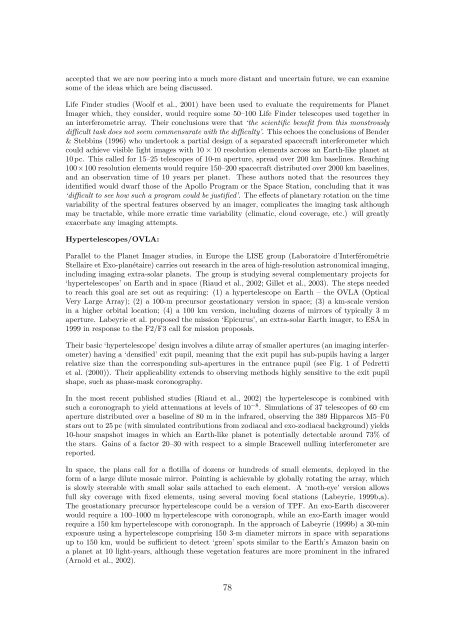Report - School of Physics
Report - School of Physics
Report - School of Physics
You also want an ePaper? Increase the reach of your titles
YUMPU automatically turns print PDFs into web optimized ePapers that Google loves.
accepted that we are now peering into a much more distant and uncertain future, we can examine<br />
some <strong>of</strong> the ideas which are being discussed.<br />
Life Finder studies (Woolf et al., 2001) have been used to evaluate the requirements for Planet<br />
Imager which, they consider, would require some 50–100 Life Finder telescopes used together in<br />
an interferometric array. Their conclusions were that ‘the scientific benefit from this monstrously<br />
difficult task does not seem commensurate with the difficulty’. This echoes the conclusions <strong>of</strong> Bender<br />
& Stebbins (1996) who undertook a partial design <strong>of</strong> a separated spacecraft interferometer which<br />
could achieve visible light images with 10 × 10 resolution elements across an Earth-like planet at<br />
10 pc. This called for 15–25 telescopes <strong>of</strong> 10-m aperture, spread over 200 km baselines. Reaching<br />
100×100 resolution elements would require 150–200 spacecraft distributed over 2000 km baselines,<br />
and an observation time <strong>of</strong> 10 years per planet. These authors noted that the resources they<br />
identified would dwarf those <strong>of</strong> the Apollo Program or the Space Station, concluding that it was<br />
‘difficult to see how such a program could be justified’. The effects <strong>of</strong> planetary rotation on the time<br />
variability <strong>of</strong> the spectral features observed by an imager, complicates the imaging task although<br />
may be tractable, while more erratic time variability (climatic, cloud coverage, etc.) will greatly<br />
exacerbate any imaging attempts.<br />
Hypertelescopes/OVLA:<br />
Parallel to the Planet Imager studies, in Europe the LISE group (Laboratoire d’Interférométrie<br />
Stellaire et Exo-planétaire) carries out research in the area <strong>of</strong> high-resolution astronomical imaging,<br />
including imaging extra-solar planets. The group is studying several complementary projects for<br />
‘hypertelescopes’ on Earth and in space (Riaud et al., 2002; Gillet et al., 2003). The steps needed<br />
to reach this goal are set out as requiring: (1) a hypertelescope on Earth – the OVLA (Optical<br />
Very Large Array); (2) a 100-m precursor geostationary version in space; (3) a km-scale version<br />
in a higher orbital location; (4) a 100 km version, including dozens <strong>of</strong> mirrors <strong>of</strong> typically 3 m<br />
aperture. Labeyrie et al. proposed the mission ‘Epicurus’, an extra-solar Earth imager, to ESA in<br />
1999 in response to the F2/F3 call for mission proposals.<br />
Their basic ‘hypertelescope’ design involves a dilute array <strong>of</strong> smaller apertures (an imaging interferometer)<br />
having a ‘densified’ exit pupil, meaning that the exit pupil has sub-pupils having a larger<br />
relative size than the corresponding sub-apertures in the entrance pupil (see Fig. 1 <strong>of</strong> Pedretti<br />
et al. (2000)). Their applicability extends to observing methods highly sensitive to the exit pupil<br />
shape, such as phase-mask coronography.<br />
In the most recent published studies (Riaud et al., 2002) the hypertelescope is combined with<br />
such a coronograph to yield attenuations at levels <strong>of</strong> 10 −8 . Simulations <strong>of</strong> 37 telescopes <strong>of</strong> 60 cm<br />
aperture distributed over a baseline <strong>of</strong> 80 m in the infrared, observing the 389 Hipparcos M5–F0<br />
stars out to 25 pc (with simulated contributions from zodiacal and exo-zodiacal background) yields<br />
10-hour snapshot images in which an Earth-like planet is potentially detectable around 73% <strong>of</strong><br />
the stars. Gains <strong>of</strong> a factor 20–30 with respect to a simple Bracewell nulling interferometer are<br />
reported.<br />
In space, the plans call for a flotilla <strong>of</strong> dozens or hundreds <strong>of</strong> small elements, deployed in the<br />
form <strong>of</strong> a large dilute mosaic mirror. Pointing is achievable by globally rotating the array, which<br />
is slowly steerable with small solar sails attached to each element. A ‘moth-eye’ version allows<br />
full sky coverage with fixed elements, using several moving focal stations (Labeyrie, 1999b,a).<br />
The geostationary precursor hypertelescope could be a version <strong>of</strong> TPF. An exo-Earth discoverer<br />
would require a 100–1000 m hypertelescope with coronograph, while an exo-Earth imager would<br />
require a 150 km hypertelescope with coronograph. In the approach <strong>of</strong> Labeyrie (1999b) a 30-min<br />
exposure using a hypertelescope comprising 150 3-m diameter mirrors in space with separations<br />
up to 150 km, would be sufficient to detect ‘green’ spots similar to the Earth’s Amazon basin on<br />
a planet at 10 light-years, although these vegetation features are more prominent in the infrared<br />
(Arnold et al., 2002).<br />
78
















